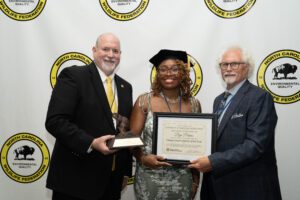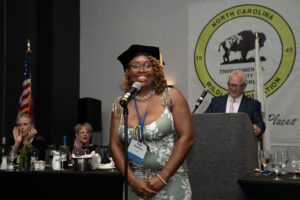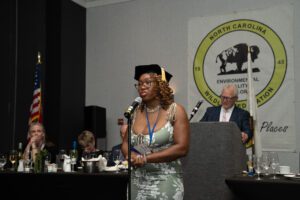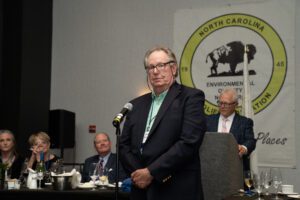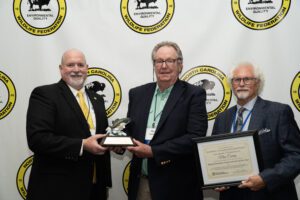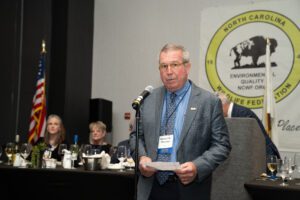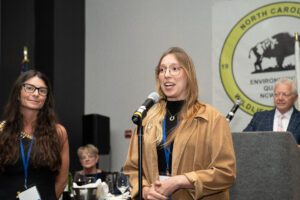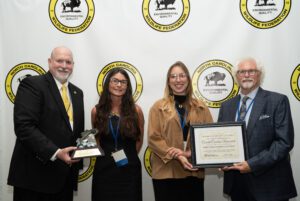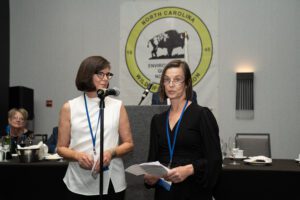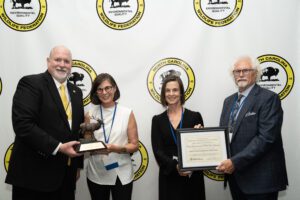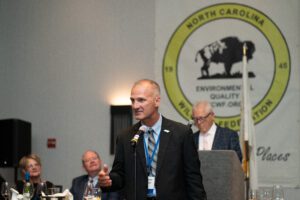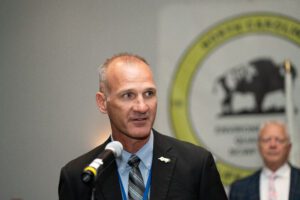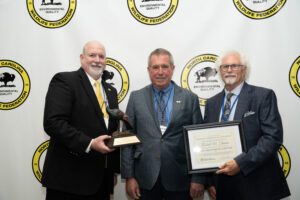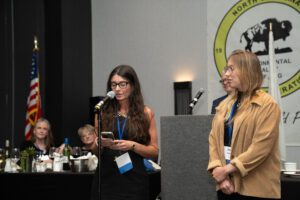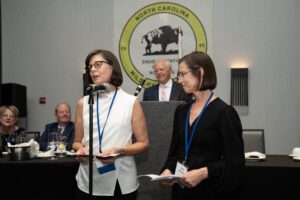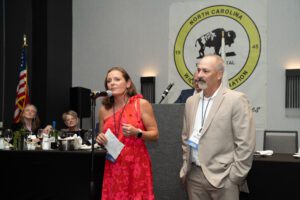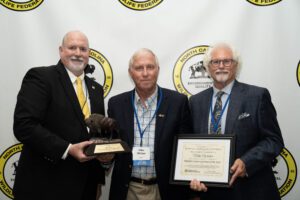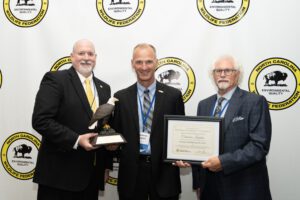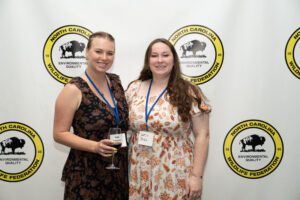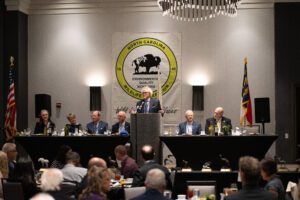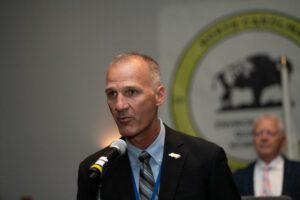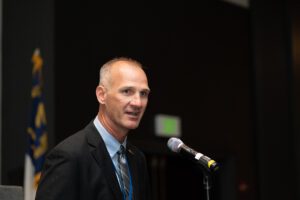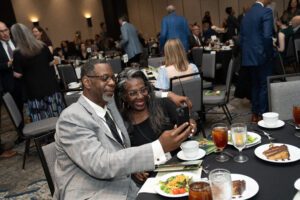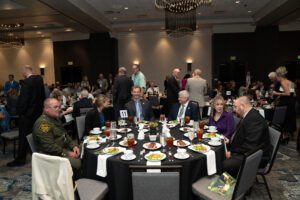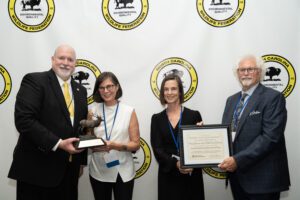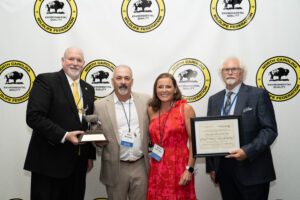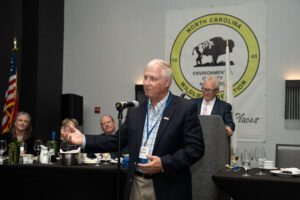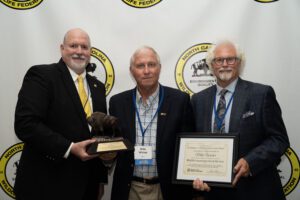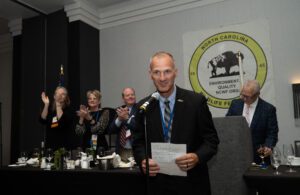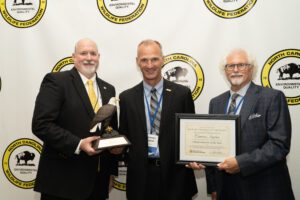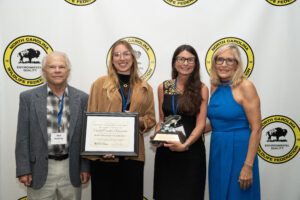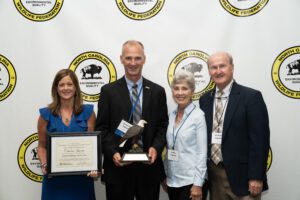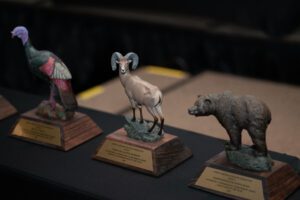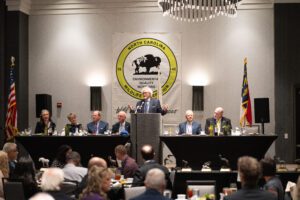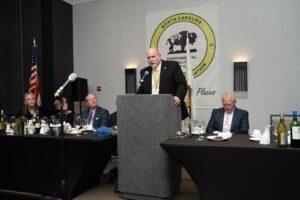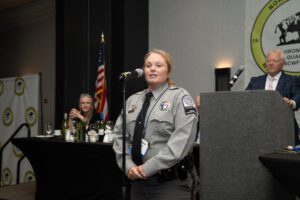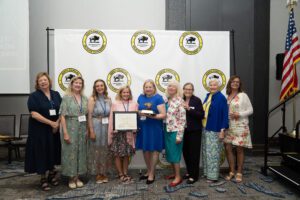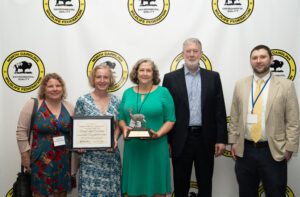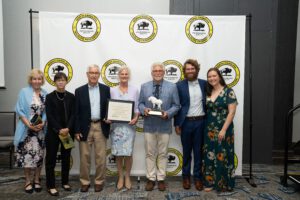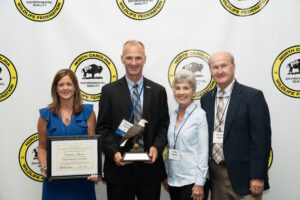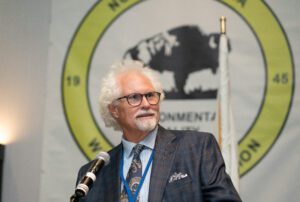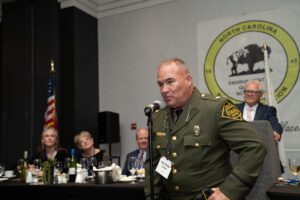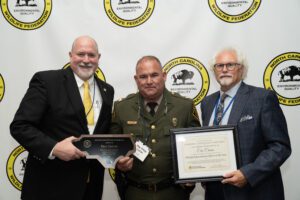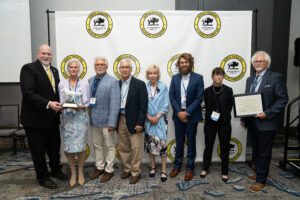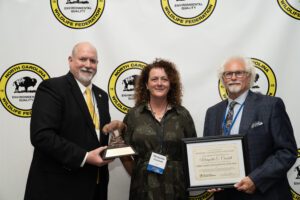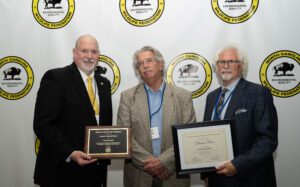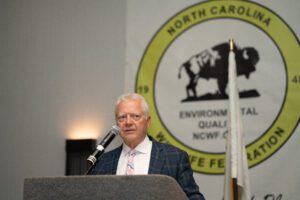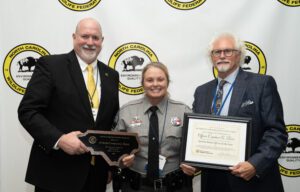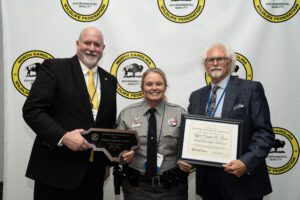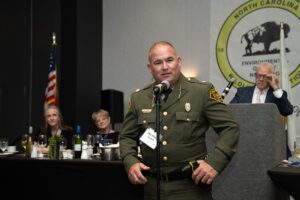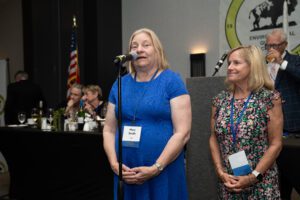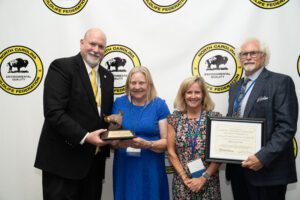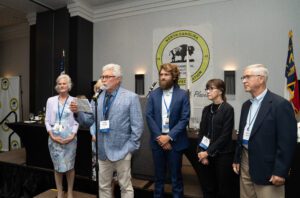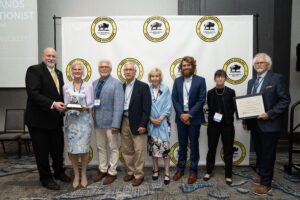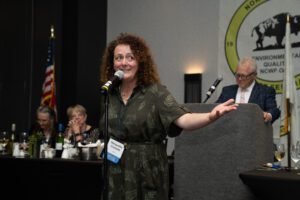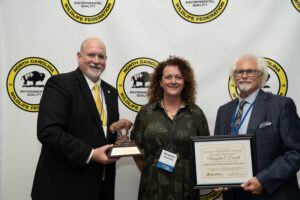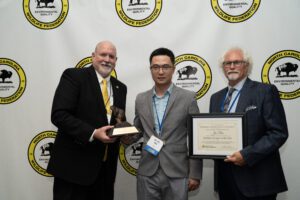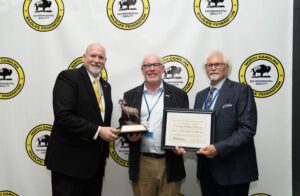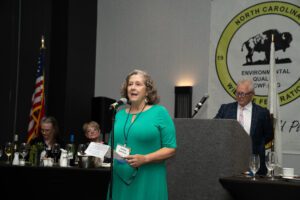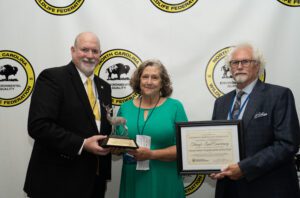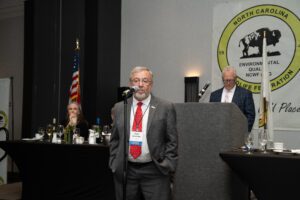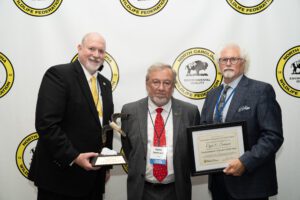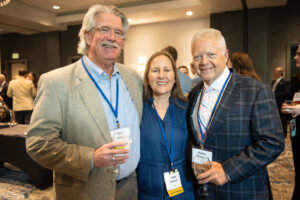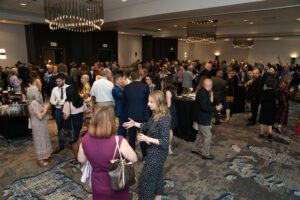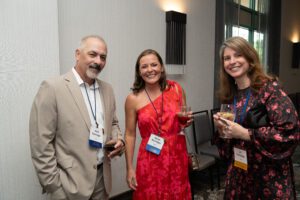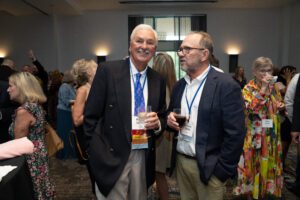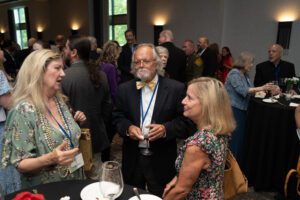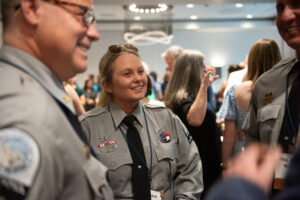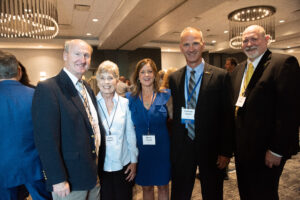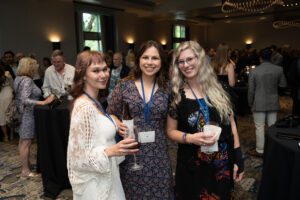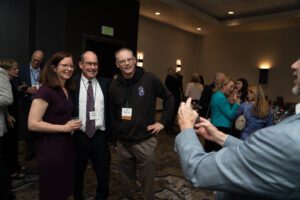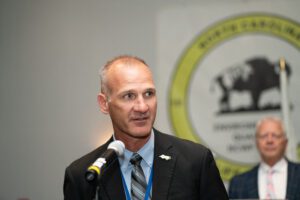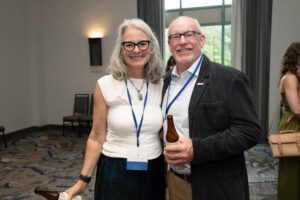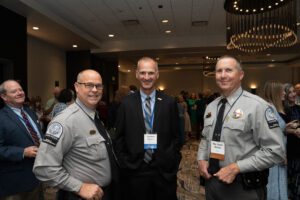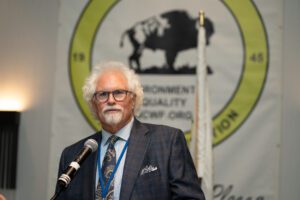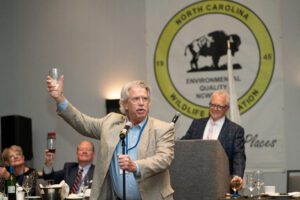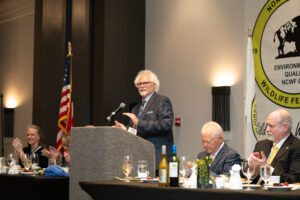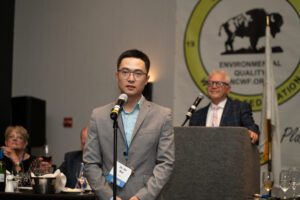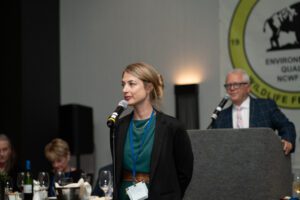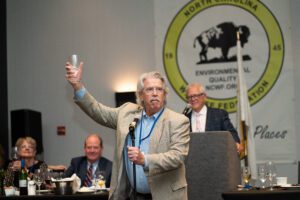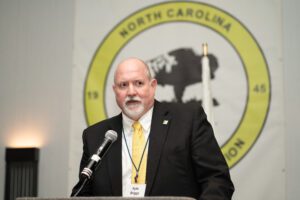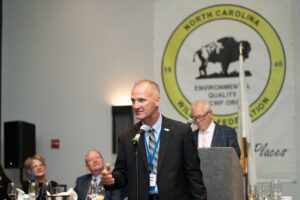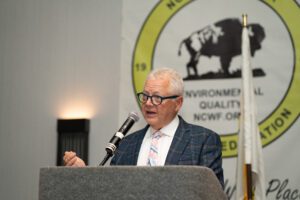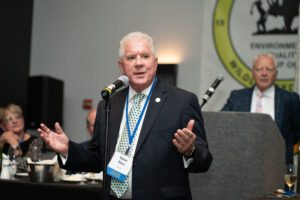On the Shoulders of Giants – Celebrating NCWF’s 60th Annual Governor’s Conservation Achievement Awards
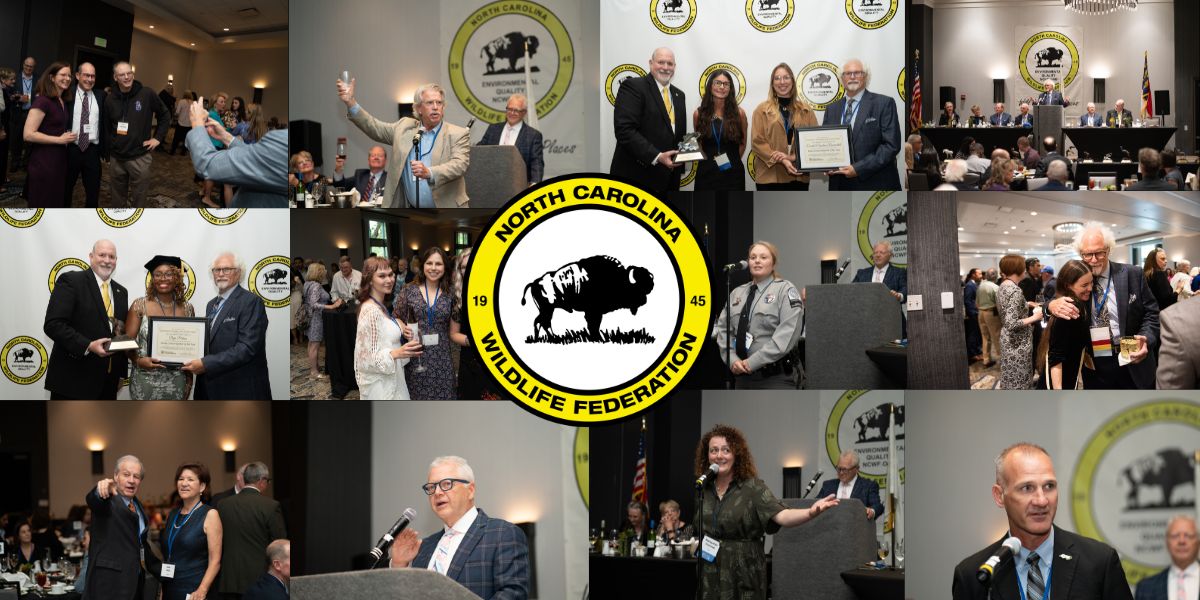
Protecting, conserving, and restoring North Carolina’s wildlife and habitats is no small task. As banquet emcee and award chair T. Edward Nickens aptly put it, it is an ongoing and formidable challenge. Yet, we are fortunate to have those who rise to this challenge—individuals and groups who are not just meeting the moment, but shaping the future of conservation.
NCWF’s 60th Annual Governor’s Conservation Achievement Awards banquet was a powerful reminder of this, bringing together 19 extraordinary conservationists whose dedication and actions are driving real, lasting change for the state’s wildlife and natural landscapes.
Nearly 300 people gathered on May 3, 2025 at the Embassy Suites in Cary to hear uplifting stories of conservation heroes in their quests to learn more, do more, protect more, work hard and fight harder for North Carolina’s wildlife and habitat.
First presented in 1958, the Governor’s Conservation Achievement Awards are the highest natural resource honors given in the state. The annual program brings together diverse conservationists to highlight wildlife conservation achievements and inspire others to take a more active role in protecting North Carolina’s natural resources for future generations.
“Those of us who work for conservation all know: We stand on the shoulders of giants. Before us, and behind us, are those whose own work and commitment paved the way for our possibilities,” said T Edward Nickens. “And the wonder of this particular conservation program is that we learn about the giants in our midst—the incredible conservation heroes working right now, in our communities.”
NCWF Board Chair Steve Jester and North Carolina Wildlife Resources Commission Executive Director Kyle Briggs presented honorees with custom-made wildlife statuettes.
Below we share highlights from T. Edward Nickens’ presentation of the awardees.
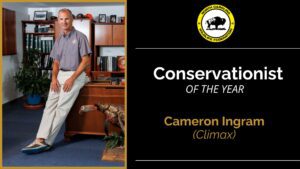
“I would love to have known Cameron Ingram’s grandmother. She was a lifelong hunter, chasing deer and rabbits and quail. She loved to bird hunt. Loved the Sandhills region where she lived in Ellerbe. And loved to hunt with her grandson, Cameron Ingram. She passed on to Cameron a philosophy of developing a relationship with the land: that there is take, and there is give. That the land only loves you back when you treat it with care and respect.
For 30 years, Cameron Ingram has built a relationship with the North Carolina landscape, and with those who love it. He’s worked his way through the North Carolina Wildlife Resources Commission, from greenhorn wildlife law enforcement officer to seasoned executive director. In the last five years, he’s led the acquisition of 30,000 acres of public lands, developed a law enforcement training facility, and moved to conserve aquatic species. And as Chronic Wasting Disease in white-tailed deer continues to expand in North Carolina, Cameron has worked towards ways to ensure that our state’s deep and beloved traditions of deer hunting are safeguarded for the future. And he’s built relationships with the broader conservation community in this state that have set the stage for future success. And there’s that word again: relationship. Put it at the top of Cameron Ingram’s accomplishments. Cameron Ingram is the Conservationist of the Year.”
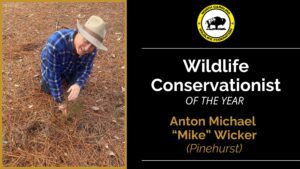
“Back in the day, before dams were built on Coastal Plain and Piedmont rivers, American shad migrated from the ocean into North Carolina rivers to spawn, and they traveled stupendous distances. American shad were known to ascend the Pee Dee River all the way to present-day Wilkesboro, North Carolina—451 river miles from the ocean—and swim up the Neuse River nearly 350 miles and up the Cape Fear nearly 300. But that was all back in the day.
It’s that kind of thought process—the contrast between what was and what is—that has fueled Mike Wicker for more than 40 years. For more than four decades, Wicker has worked with the U.S. Fish & Wildlife Service, serving as NC Coastal Program Coordinator. And he was sick and tired of hearing how things were back in the day. So, he worked to pull out dams on the Neuse and Little Rivers so American shad could regain their historic migration routes. And he worked to restore Atlantic white cedar in the Coastal Plain, a stunning tree beloved by the old decoy carvers. And he’s worked to bring back Lake Mattamuskeet, the jewel of the Coastal Plain, beleaguered with problems with water quantity and quality. “Back in the day” was a sort of rallying call for Wicker, spurring him to work for a day when the future in the Coastal Plain will be just as thrilling as the past. We may never again be able to walk across rivers on the backs of migrating herring and shad, as the old folks talk about. But when we do marvel at the incredible abundance of North Carolina rivers, it will be in large part because of the work of Mike Wicker, the Wildlife Conservationist of the Year.”
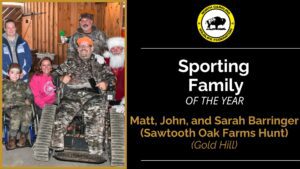
“It’s just one weekend. One fall weekend near Richfield, and Gold Hill, and Mount Pleasant. Just one weekend when hunters in those communities give up their best hunting spots, and share trail camera photos, and serve as hosts and guides, and provide food and lodging, so some 70 differently-abled hunters—who probably wouldn’t make it to the woods without the helping hands of others—can experience the hunt. For the last 18 years, on one magical weekend, Matt, John, and Sarah Barringer have led the Brent Barringer Memorial Hunt on their Saw Tooth Oak Farm that straddles the Stanly and Cabarrus County line. Held in honor of Matt’s cousin, Brent Barringer, who lived with physical and mental challenges due to a brain tumor and passed away in 2004, the Brent Barringer Memorial Hunt now involves more than 120 local businesses and individuals, with more than 100 volunteers. Local residents provide home-cooked soup, fry fish, smoke pork shoulders, and make homemade desserts. Local hunters serve as guides. Local folks donate to an auction that draws more than 400 people. And the hunt has expanded to turkey season. And the effort has underwritten financial support for numerous track chairs and power wheelchairs donated to hunters who need them.
Just a weekend in the woods. A few days that preserve the memory of a beloved young man and have enabled more than 1,000 others the opportunity to experience the world he so loved. Matt, John, and Sarah Barringer are our Sportsmen and Sportswoman of the Year.”

“Plan your work, and work your plan. There may be no better mantra to describe what has driven the success of Amy and Ruth Ann Grissom’s decades-long effort to conserve and caretake nearly three and a half square miles of rural lands near or adjacent to Uwharrie National Forest. These sisters have intentionally managed some 3,000 acres of one of the oldest landscapes in North Carolina. Amy focuses on strategic acquisition. Ruth Ann is similarly strategically involved in enhancing forest tracts utilized by Species of Greatest Conservation Need. Together, the sisters maintain nearly 1,700 acres along the Uwharrie River, which is of Very High significance by the NC Natural Heritage Program. They manage 150 acres of commercial pine plantation in ways that it will eventually be converted to longleaf or shortleaf pines, both of which are declining in North Carolina.
You name it—if it increases biodiversity and resets the time clock for wildlife, the Grissom sisters are on it. Establishing forested riparian buffers. Supporting university and state agency research. More than 65 bird species have been captured on the property, with more than 5,000 banding captures. Public events, private events, government events—if it benefits wildlife, check, check, and check. And none of it is by accident. Amy and Ruth Ann Grissom are the Land Conservationists of the Year.”
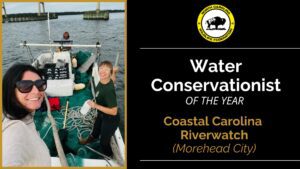
“Think about… what water has to put up with. Water. As in, our rivers, and sounds, and marshes. The nearshore ocean. Tidal creeks. If you spend any time at all on the coast, just think about what we do to that water. We dump our sewage into it, the effluent from countless factories and plants, chemicals from countless farms, oil and motor… crap… from countless parking lots and driveways. Waste from countless hogs and chickens and cows, trash and godawful birthday balloons—and if you ever invite me to a party where you release balloons into the sky, I’m telling you now I cannot be judged on my behavior. Jailed, most likely, but not judged.
Anyway. I’ve said, as an angler, that the most amazing thing about the marine environment today is that there is anything… anything… still alive in it. And I’m not judging. I run a 300-hp outboard. But think about what our water has to put up with. That there is anything alive in our coastal rivers and sounds and marshes is largely, massively, due to the work of advocates like the Coastal Carolina Riverwatch, whose office is mere blocks from my place in Morehead City. From the New River at Jacksonville to the White Oak River in Swansboro to the rest of the Crystal Coast all the way to Cedar Island, Coastal Carolina Riverwatch monitors water quality, monitors policy, monitors politicians, monitors what goes into the water so that water can do what water should do: support healthy human ecologies and economies.
Here’s what Coastal Carolina Riverwatch does, straight from their web page on the World Wide Inner Tube: We protect the quality of water and quality of life in coastal NC. That’s as simple and straightforward a message as you’ll ever hear. And it’s as complicated and difficult and World-Wide-times as heartbreaking an endeavor as you could ever imagine. Coastal Carolina Riverwatch is the Water Conservationist of the Year.”
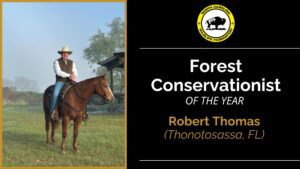
“One thing you can say about Robert Thomas: the man stands firm. His family has owned some 5,000 acres in the North Carolina mountains for nearly 60 years. They’ve managed it for wildlife habitat and water quality, managed it to protect viewsheds from the Blue Ridge Parkway and water in trout streams. And Thomas and his family wanted to make those protections permanent with a Forest Legacy agreement in 2003. One single vote in the U.S. House killed the deal. A massive 4,000-home development went in next to the Thomas land. The family could have made kajillions. Thomas held the line. The market for hardwood timber in western North Carolina crashed. Plans to use the proceeds from wildlife-friendly timber harvests burned down along with it. The Thomases were undeterred. Even John Dutton would have caved along the way.
In November of 2024, after two decades of trying to permanently protect the land, the family inked an agreement with the Conservation Fund to sell, at bargain prices, easements along 1,247 acres adjacent to the Blue Ridge Parkway and the Mountains-to-Sea Trail, which will be stewarded by Mainspring Conservation Trust, and—jillions—a 2,703-acre working forest nearby, to be stewarded by the NC Forest Service. In the future, when folks look out over Jones Creek, and Queen Camp Creek, and Cabin Creek, and marvel at the vernal landscape of this big chunk of North Carolina, they can thank their lucky stars that it’s not all covered in a chaos of concrete. Or they can thank Robert Thomas, our Forest Conservationist of the Year.”
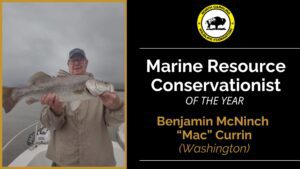
“There is a line of reasoning that insists scientists be as dispassionate as possible when it comes to their fields of study—that scientists must somehow whittle away whatever personal passion or emotion or “feelings” they might have about their subjects of inquiry, and be solely concerned with the data. To which Mac Currin might say: Maybe. But I really, really love to go fishing.
As his nominator wrote, Currin is the most consummate angler he’s ever known, with equal parts love of the resource and a critical, scientific eye. He has studied larval transport of fish through North Carolina’s inlets, and been instrumental in the development and implementation of the NCSU Extension department’s highly lauded saltwater fishing school. He has served on the NC Marine Fisheries Commission and as the North Carolina representative to the South Atlantic Fishery Management Council. He’s worked offshore and inshore. He’s held office jobs and field jobs. He’s worked intensively behind the scenes to assist in the development and implementation of the NC Fishery Reform Act and the associated Coastal Habitat Protection Plan, and he’s been out front with the NCWF and NCCCA in his advocacy; Currin is a plaintiff in the NC-CCA’s suit against the State of North Carolina, which seeks to require the State to uphold its public trust responsibilities with respect to estuarine and marine fishery resources.
So, whether during his career or during his retirement, whether working to improve marine fisheries or improve an angler’s fishing techniques, there is one place where you never would have found Mac Currin, and never will: on the sidelines. He is the Marine Resources Conservationist of the Year.”

“There is a phrase I love to use because I think it makes me sound so smart. It’s called “the interstitial spaces.” It means the spaces between things that seem like they don’t really have space between them. Got it? It’s like the spaces between the sand grains on a beach. They’re there, and they are full of microscopic organisms that help support the entire web of life on a beach. Interstitial spaces. The places we overlook.
Deja Perkins doesn’t overlook the interstitial spaces. Perkins is a PhD candidate in Geospatial Analytics at NC State University, and she’s particularly interested in filling in the gaps of knowledge and lived experience for Black and Brown North Carolinians who lack access to nature and to the concepts of stewardship. Perkins grew up in Chicago, surrounded by factories, environmental pollutants, and a lack of nature access. When she moved to Raleigh, she never would have imagined living side by side with red-shouldered hawks and barred owls, and osprey and bald eagles. In addition to her studies, she’s started a company, Naturally Wild LLC, that focuses on fostering connections to our local nature, promoting stewardship, and encouraging urban Black and Brown residents to embrace the wild spaces and organisms that exist within our neighborhoods. From specialty workshops to free monthly bird walks, virtual talks, and youth programming, Perkins works to build connection.
We live in a moment in which the gaps between people, and perspectives, and politics, and opinions are having monumental impacts on policy, on wildlife, on the natural world, and on human relationships. Too many people fear the gaps between us. We’re fortunate to have people like Deja Perkins who not only have no fear of these interstitial spaces, but are drawn to consider them deeply, so that one day the fear, and the gaps, might disappear. For her ongoing work to diminish the things that separate us from the wild, and from one another, Deja Perkins is the 2025 Young Conservationist of the Year.”
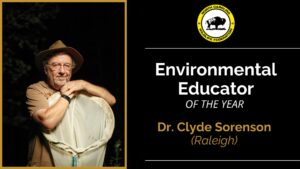
“I want to say upfront that my personal feelings about Clyde Sorenson did not factor into the Awards Committee’s deliberations about this category. We take our job seriously, and leave personal feelings at the door. But I want you to know, because I know Clyde, that Clyde Sorenson is one cool dude. He might be an ace scientist, a beloved teacher, a fabulous writer, a hoot to be around, and a pleasure to call friend, but aside from all that: One. Cool. Dude.
The good professor Dr. Clyde Sorenson is an entomologist at North Carolina State University. He studies bugs. He might be a cool dude, but still, the man studies bugs. But Clyde has found a way—found many, many ways—to excite folks about the marvel and the wonder and the close-at-hand utter awesomeness of the Insect Kingdom. He’s taught more than 10,000 students about the importance of insects to the natural world and to human societies. He’s amazed thousands of readers of Wildlife in North Carolina with his wonderful Nature’s Ways columns. Recently, he most likely discovered a new species of firefly, related to the fabulous blue ghost firefly.
But as much as Clyde loves a bug, and a beetle, and all manner of creeping and crawling things, I don’t think he loves anything like the light he sees in a young student’s eyes that suddenly flashes with understanding, and appreciation, and even a special kind of zeal that converts knowledge into action. I’ve read some of Clyde’s students’ comments about his classes. They include words like awesome, and passion, and approachable, with an enthusiasm that is infectious. Honestly, at times it sounds like they’re talking about Taylor Swift, but I’m pretty sure it’s all about Clyde. Let me read you just a quick two-sentence snippet. This is a student talking: “I would never have imagined how much I enjoyed learning about entomology in his class. We need more men like Dr. Sorenson.”
Yes, we do. Folks who know that when it comes to wildlife, there is no such thing as a little thing. Dr. Clyde Sorenson is the Environmental Educator of the Year.”
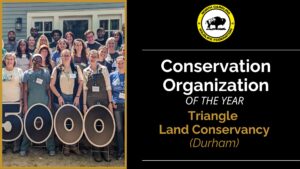
“We’ve all heard the old saying that they don’t make land any more. Let me tell you what else they don’t make enough of anymore: It’s people who can look at a piece of land—a piece of land that hasn’t been “improved.” A piece of land that isn’t being “productive.” A piece of land that hasn’t been developed and sits there, right in front of your face, doing nothing for nobody. They don’t make enough people who will look at that land and say: Don’t freaking touch it. Because it’s perfect. And nothing you can do—other than get rid of some kudzu, maybe—is going to make it any better.
For 42 years, the Triangle Land Conservancy has been working to conserve land that isn’t doing a dadgum thing. Except cleaning water. And pumping out oxygen. And providing critical wildlife habitat. And giving folks places to hike and heal. 2024 was a milestone year for TLC, as the organization beat its goal announced in 2018 of conserving 25,000 acres by 2025—by a full year. And in just the past year, TLC protected 1,544 acres valued at $26 million and has an additional 1,800 acres in the works. Land that’s just sitting there. Doing nothing. Except everything.
Last year I got to see how TLC works, up close, as I watched with great interest how they moved to purchase and conserve 400 acres of Upper Neuse River farm and forestland, which I roamed for 14 years. I saw how they worked with the farmer who leased the land to help maintain his stewardship. I saw how deeply they dug for some $3 million to make the deal work. I saw how they took a piece of property that most likely was slated for warehouses and turned it into a cornerstone of open land in one of the most highly pressured corners of the Triangle.
In short, I saw why Triangle Land Conservancy has been named the Governor’s Conservation Organization of the Year.”
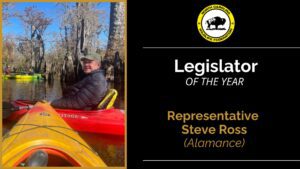
“It might come as a surprise to some people, but the most substantive and impactful conservation programs politicians grapple with don’t necessarily deal with clean water or wildlife habitat or endangered species. They deal with farmland, and how farmers are supported in their efforts to feed their communities in ways that benefit wildlife and water, clean air, and pollinators. North Carolina’s state conservation tax credit has been a vital tool in maintaining healthy ecosystems across the state, and it has been repeatedly weakened in the legislature. Thankfully, Rep. Steve Ross from Alamance County took up the cause of restoring North Carolina’s conservation tax credit through the state Farm Bill, and in 2024, he led efforts to ensure that an incentive remained to support landowners who wished to set aside parts of their lands or donate conservation easements to conservation groups. Ross understood that a voluntary program, entered into without coercion, is worthy of support by the government of North Carolina, for the people of North Carolina. For that vision, Rep. Steve Ross is the Legislator of the Year.”
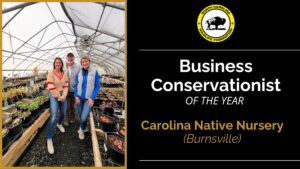
“They could have given up. I might have given up. You might have given up. But Bill Jones and his Carolina Native Nursery in Burnsville didn’t give up. When Hurricane Helene destroyed 90 percent of his inventory, Bill knew there was no way he could sell recovered plants due to potential floodwater contaminants. But that didn’t mean he couldn’t give them away. So, he partnered with the group BeLoved Asheville to find meaningful ways to use them. Together, they identified nonprofits and organizations that could benefit from the plants, ensuring they would serve a greater purpose in rebuilding and education efforts. Carolina Native Nursery gave away 5,000 native treasures, for no cost, but only with the promise that they would be used for restoration purposes after the hurricane.
Twenty-six parks, land trusts, wildlife centers, educational institutions, and community properties were the beneficiaries of the tragedy of Hurricane Helene. Bill Jones and Carolina Native Gardens used devastation to nourish new relationships, and helped their neighbors jumpstart a healing process that will continue for years. Carolina Native Landscapes is the Business Conservationist of the Year.”
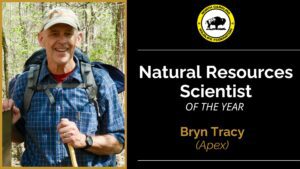
“If you’ve ever held a little minnow in your hand, and looked at it closely, and wondered, does a line drawn from the posterior corner of the upper lip, immediately anterior to the maxillary barbel, does it extend vertically to the anterior edge of the bony orbit? In other words, if you’ve asked yourself, is this a thicklip chub, Cyprinella labrosa, OR… a thinlip chub, Cyprinella zanema? Ahhhh. If either of these questions has entered your consciousness, Bryn Tracy’s kind of cat.
Now, you may not obsess over the relative lip positions of native freshwater fish, but Bryn Tracy does. First as a biologist for Carolina Power & Light Company, then as the Principal Fisheries Biologist for the Water Sciences Section for the NC Division of Water Resources. Since his retirement in 2020, he’s been a dedicated volunteer at the NC Museum of Natural Sciences. And he was lead author on a gorgeous book just recently published by UNC Press, A Guide to North Carolina’s Freshwater Fishes, which will not sell as many copies as Bill Belichick’s latest book, but it should.
Let me tell you something else Bryn Tracy obsesses over: A North Carolina that takes care of its native fish populations like the global trove of biodiversity that they are. For all of these reasons, Bryn Tracy is the Governor’s Natural Resources Scientist of the Year.”
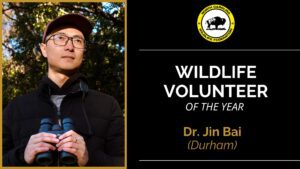
“I think that scientists who study birds do some of the most fascinating research in the world. Birds share every aspect of human lives, because they live everywhere we live. No class of animals tells us more about what’s happening in our world, in real time, than birds. Listen to what Jin Bai was up to during the COVID pandemic, while I was washing grocery cans and learning how to make friendship bracelets with my 24-year-old daughter. Jin completed a PhD in 4 years during the pandemic lockdown. He turned the pandemic into a research opportunity to study the effects of lockdowns—the so-called Anthropause—on urban birds. For this, he used large datasets from eBird and Google’s COVID-19 Mobility Report to analyze how changes in people’s mobility may have impacted the distribution of birds across North Carolina. Alongside this, he coordinated the Triangle Bird Count to engage residents in documenting the distribution of birds across the Research Triangle. And, he conducted his own fieldwork to address questions about how the history of implementing the housing policy known as Redlining impacts urban tree canopy cover and the distribution of bird diversity in Durham, NC. And he developed a side project, founding a nonprofit to address the problem of birds dying from hitting windows in urban areas. He worked with students to document the extent of bird-window collisions across three campuses (NC State, UNC-Chapel Hill, and Meredith College). In each of these projects, Jin demonstrated exceptional skills in field data gathering, collation of data from citizen scientists, and use of nontraditional information sets like Zillow’s real estate database for practical conservation significance.
Now, I’ll put my killer friendship bracelets up against anybody’s, so it’s not like I was wasting my time during Covid. But I’m no Dr. Jin Bai, the Wildlife Volunteer of the Year.”
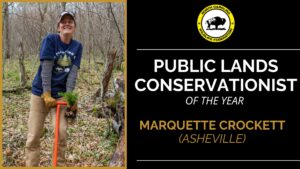
“Quick quiz: What do the following have in common: Endangered spiders, wild hogs, flying squirrels, weed-eaters, restored groves of American chestnuts, incarcerated non-violent inmates, and goats? A lot of goats. That’s like the craziest Venn diagram you’ll ever see, and there’s only one answer: Each of these is a piece of the complicated chess game Marquette Crockett plays in her efforts to conserve the Roan Mountain massif, one of the true wonders of the Southern world.
Crockett is the Roan Stewardship Director for the Southern Appalachian Highland Conservancy, now in her 11th year working to keep one of the wildest, and most imperiled, mountain regions in North Carolina wild and free from peril. She leads efforts to restore forests of red spruce and wide open grassy balds that attract visitors from around the world. She works to keep those visitors from trampling the very ecology they’ve come to marvel at, and works to keep the Roan Highlands balds a place where Gray’s Lily will bloom for all time. She has successfully written grants for nearly $1 million dollars in restoration work.
Marquette Crockett is an 8th-generation Appalachian, which means she can be tough as granite and smooth as a stream-smoothed boulder, on the same day, in the same meeting. There are a lot of people in this state who believe that Roan Mountain is the finest chunk of ground that exists in this state, and the good people of Tennessee probably think that too. They all—we all—owe a debt of gratitude to Marquette Crockett for making sure it stays that way. She is the Public Lands Conservationist of the Year.”
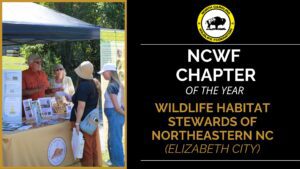
“It’s sort of a double-edged sword. A lot of folks don’t really know much about northeastern North Carolina. They’re just not familiar with the Pungo, Pasquotank, and Scuppernong Rivers, or the wilds of the Chowan, or the shores of northern Currituck Sound. They don’t know about the beauty of a sunset over a Camden County beanfield, or the thrill of a glimpse of a black bear making its way through the pinewoods.
But the members of the Federation’s chapter in that area, the Wildlife Habitat Stewards of NE North Carolina, know all this, and they know it’s only going to be there for future generations if this generation takes care of it. So, they’ve planted serviceberries and pollinator plants, helped restore Atlantic White Cedar, and shepherded educational events at Pocosin Lakes National Wildlife Refuge and the Red Wolf Center. They want other North Carolinians in on their little secret: the northeastern corner of North Carolina isn’t a diamond in the rough. It’s a forest-green and river-blue jewel that’s holding fast to its wild heritage.
The Habitat Stewards of Northeastern North Carolina is the Wildlife Federation Chapter of the Year.”
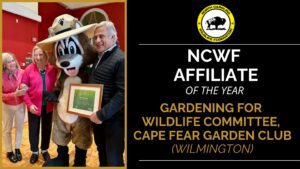
“This isn’t the Cape Fear Garden Club’s first rodeo in the Governor’s Conservation Achievement Awards Program. We’ve heard about these folks before, and we’ve always been impressed. But last year, they swung for the fences. The Club’s Gardening for Wildlife Committee set a goal of having the entire city of Wilmington certified as a Community Wildlife Habitat. They rallied NCWF’s Natalie Bohorquez to speak about native plants, pollinators, and the Butterfly Highway. They hosted Dr. Doug Tallamy from Delaware to speak about sustainable gardening practices. They held Arbor Day tree plantings, an Earth Day booth, and programs on sustainable mosquito control practices. Along the way, a proclamation was passed by the mayor’s office declaring May 2024 as Gardening for Wildlife Month for the city of Wilmington.
And just six weeks ago, a celebration of Wilmington’s official certification as a Community Wildlife Habitat was held at the Historic Thalian Hall Ballroom.
The Cape Fear Garden Club is the NCWF Affiliate of the Year, and I suspect it’s not the last we’ve heard from these fine folks.”
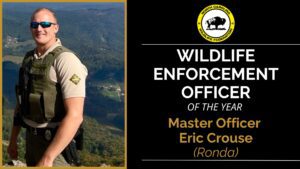
“It’s getting complicated out there. Master Officer Eric Crouse knows that better than anyone. Even in Wilkes County, where folks take pride in living a simpler kind of lifestyle, things keep getting complicated. Criminals using thermal imagery to spotlight deer at night. Check a hunter for a hunting license, and you find a bunch of drug paraphernalia. Even folks who are trying to do things right are having to deal with complications folks couldn’t have conceived of 20 years ago—Chronic Wasting Disease. Public-private conflicts over trout waters.
Wildlife law enforcement officers sort of chuckle when the notion of being a “game warden” comes up. The reality of what it takes to be a wildlife law enforcement officer these days is a complex mix of straight-up enforcement work, old-school game wardening, forensic analysis, and, frankly, social work. It takes a special kind of person to excel in all those areas, and Officer Crouse exemplifies that kind of person. He is a mentor, an innovator, and a lifesaver. He recently treated a gunshot victim he found lying in the road by utilizing a trash bag as a tourniquet. If you’re in trouble, Eric Crouse is the guy you want on the scene. If you’re causing trouble, well… not so much.
Master Officer Eric Crouse is the Wildlife Law Enforcement Officer of the Year.”
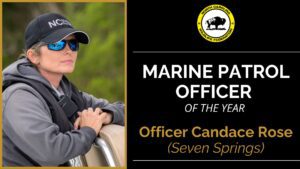
“The word “serve” has an interesting history, and one we would do well to examine these days. It comes from the late 12th-century Old French term servir, which meant “to show devotion to, to be in service to the point of putting the lives of others before your own.” Over the centuries, the meaning shifted. In the 14th century, the word came to mean “to be useful, to be beneficial, to be willing to provide purpose and function.” I’m not sure I’ve ever read an account of anyone who matches the centuries-old meanings of “service” as does Marine Officer Candace Rose. You can read her quick bio in your awards booklet: ten years as a state park ranger, a degree in parks and recreation management, eleven years in the North Carolina Army National Guard, retiring as a Major. And in the middle of all this, she thought, “Oh! I haven’t given enough, haven’t served enough. I’ll sign on as a Marine Enforcement Officer, one of the most misunderstood law enforcement positions on the planet. And maybe I’ll train as a Swift Water Rescue Team member and as an EMT.” That all sounds fun, doesn’t it?
The flip side of that old word “serve” is self-serve, and I’m not talking about ice cream. That’s service in the cause of elevating yourself, and no one could ever mistake Officer Rose’s selfless service for that. All her life, she has shown her devotion to the people of North Carolina. She is inspiring and worthy of emulation, and she is the Marine Patrol Officer of the Year.”
Event Sponsors Support Conservation Heroes
Thank you to the following partners, businesses and individuals for helping us honor and celebrate North Carolina’s top-notch conservation leaders of 2025.
Diamond sponsor: Duke Energy

Platinum Sponsors
John Robbins
Gold Sponsors
Grady-White Boats
Jordan Lumber
NC Electric Cooperatives
Silver Sponsors
James and Lauren Shaughnessy
Native Roots NC LLC
Bronze Sponsors
David Knight
Faircom New York
Higgins Benjamin
Martin Marietta
National Wildlife Federation
The Rutledge Family


